The Belmonts - Tell Me Why: The Very Best Of The Belmonts (2002)
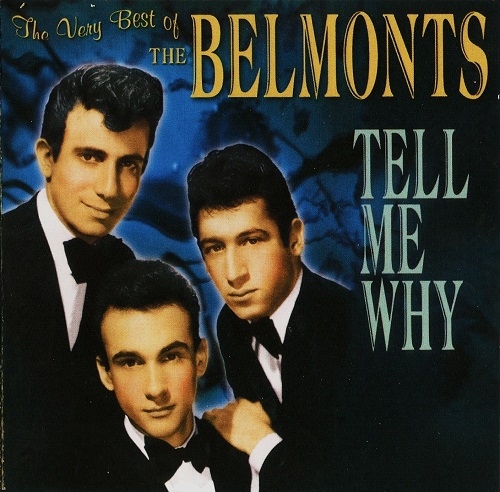
Artist: The Belmonts
Title: Tell Me Why: The Very Best Of The Belmonts
Year Of Release: 2002
Label: Collectables
Genre: Doo Wop, Oldies
Quality: Mp3 320 / Flac (image, .cue, log)
Total Time: 01:04:48
Total Size: 161/409 Mb (scans)
WebSite: Album Preview
Title: Tell Me Why: The Very Best Of The Belmonts
Year Of Release: 2002
Label: Collectables
Genre: Doo Wop, Oldies
Quality: Mp3 320 / Flac (image, .cue, log)
Total Time: 01:04:48
Total Size: 161/409 Mb (scans)
WebSite: Album Preview
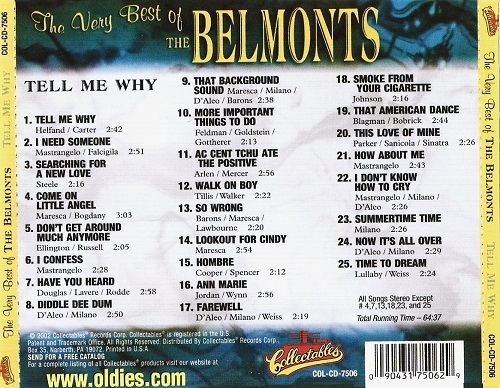
Tracklist:
01. Tell Me Why
02. I Need Someone
03. Searching for a New Love
04. Come on Little Angel
05. Don't Get Around Much Anymore
06. I Confess
07. Have You Heard
08. Diddle Dee Dum
09. That Background Sound
10. More Important Things to Do
11. Ac-Cent-Tchu-Ate the Positive
12. Walk on Boy
13. So Wrong
14. Lookout for Cindy
15. Hombre
16. Ann Marie
17. Farewell
18. Smoke from Your Cigarette
19. That American Dance
20. This Love of Mine
21. How About Me?
22. I Don't Know How to Cry
23. Summertime Time
24. Now It's All Over
25. Time to Dream
The history of the Belmonts is usually linked to that of their lead singer, Dion (born Dion DiMucci, July 18, 1939), with whom they had their biggest hits. In point of fact, however, the link up between Dion and the Belmonts actually lasted only two years, and the group existed (albeit briefly) prior to and a long after his time with them. Angelo D'Aleo (born February 3, 1940), first tenor; Fred Milano (born August 22, 1939), second tenor; and Carlo Mastrangelo (b. October 5, 1938), baritone; and Dion DiMucci were all friends from the area around Belmont Avenue in the Bronx, in N.Y.C. They attended Roosevelt High School and hung out together, and all of them sang; D'Aleo, Milano, and Mastrangelo began singing together and named themselves the Belmonts. As a trio, they recorded for the Mohawk label in 1957, making their debut with the song "Teenage Clementine," which came and went without notice. It was when Mastrangelo wrote a song of his own, "We Went Away," that was heard by Dion, that the quartet came together. It was recorded for Mohawk under the direction of conductor/arranger Hugo Montenegro (who had previously arranged an abortive debut single by Dion with a separate backing group), and the B-side got onto several local radio play lists.
The group moved to Laurie Records, newly founded by Bob Schwartz (who'd been a part-owner of Mohawk) and his brother Gene, and, with Dion as lead singer, cut their label debut with "I Wonder Why." The latter made it to number 22 on the pop charts, making them a hot act in New York and the Northeast. It was followed by a pair of hits, "No One Knows" and "Don't Pity Me," which peaked at 19 and 40, respectively. "A Teenager in Love" made number five, and further hits with "Where or When" and "When You Wish Upon a Star" elevated Dion & the Belmonts as a major national act. Dion DiMucci was clearly the star of the group, in presentation and billing, but the vocal talents of the group were displayed equally well, if not as prominently, on most of those hits and the tracks cut for their LPs. Their own musical tastes diverged somewhat from those of their lead singer, into jazz, pop ballads, and other areas, while Dion preferred harder rock & roll sounds and later gravitated toward blues.
In 1960, Dion decided to pursue a solo career and parted company with the Belmonts. The usual perception is that the group disappeared after this, but the truth is that the Belmonts continued to enjoy success for the first year after his departure. The trio remained with Laurie Records for one single, "We Belong Together," featuring Carlo Mastrangelo as lead singer, and then formed their own label -- originally named Surprise, and then Sabrina, it was finally christened Sabina Records when those two earlier choices proved to belong to other companies. The label became active (as Surprise) in March of 1961 with the recording of "Tell Me Why," which rose to number 18 nationally. The follow-up record late that summer, "Don't Get Around Much Anymore," rose to a modest number 57, and the next release, "I Need Someone," only got to 75.
The Belmonts' fortunes picked up again with their Sabina single "Come On Little Angel," written by Ernie Maresca. Produced by Gerry Granahan, an established songwriter and recording star (as Dickie Do & the Don'ts), who also oversaw the operations of the company, the single got to number 28 during the summer of 1962. The group also made a bad miscalculation around this time when Maresca offered them the first crack at a song entitled "The Wanderer," and the Belmonts turned it down, only to see it become a massive hit -- indeed, a signature tune -- for Dion. A major lineup change then occurred, when a split developed within the group over their business affairs and the financial condition of Sabina Records; Mastrangelo exited the Belmonts in favor of trying to record solo for Laurie Records. The group carried on, replacing him with Frank Lyndon, and released their first LP, Carnival of Hits, late in 1962 to try and capitalize on "Come on Little Angel."
Sabina Records began diversifying its catalog slightly, releasing "Time to Dream," which was credited to Buddy Christie and Buddy Sheppard, with the Belmonts singing back up as "the Holidays." They also recorded material by a friend of theirs from the Bronx, Pete Barin, but the label couldn't seem to click with any records except those by the Belmonts themselves, and that was changing. By 1963, the Belmonts were not only struggling for a hit, and battling the woefully under-financed condition of their record label, but also changes in public taste. Dion had managed to keep his music current as a solo performer and racked up some huge hits in the process, through 1963, but the Belmonts, by the nature of their name and their harmony sound, seemed more dated. A brief revival in doo wop music in 1961 had been a godsend to the trio, in terms of bookings as well as record sales, and there'd been lots of work in New York and the surrounding area, at a time when they were just coming off of several big hits with Dion. By this time, there were other harmony-based groups out there recording and adding their own respective wrinkles to the music, including the Beach Boys and, closer to home, the East Coast-based Jay & the Americans and the Four Seasons, both of whom had a more commercial sound than the Belmonts. The sales of their own records began declining around this time, "Diddle-Dee-Dum" getting to number 53 and "Ann-Marie" to number 86 in 1963.
Sabina Records struggled on through a handful of additional releases by the Belmonts that never charted, and finally, in 1964, folded. The group moved to United Artists Records that year, and cut their final recordings from this part of their history there in 1966. The trio disbanded that year, although they were back together in 1967 on ABC Records with Together Again, an album that reunited them with Dion. The group remained active after this, cutting an album entitled Summer Love on the Dot Records label in 1969.
The group next became visible in the early '70s, amid the oldies boom. They cut an album for Buddah Records entitled Cigars Acappela Candy, on which they performed several classic oldies tracks and also applied their sound to contemporary hits like "My Sweet Lord" and "Na Na Hey Hey (Kiss Him Goodbye)." In 1972, however, they reunited with Dion for what proved to be the biggest single gig in their history, a performance at New York's Madison Square Garden, which was not only a sell-out event but also recorded for posterity and released as Live at Madison Square Garden 1972. Milano, Mastrangelo, and D'Aleo were the participants in that performance, which was reportedly released two different ways -- the original Warner Bros. LP was heavily sweetened in the studio, where the subsequent reissues (including the Rhino CD) were made from untouched tapes from the original show. The Madison Square Garden show and its aftermath, which included performances together in 1973 as well, basically allowed all concerned to grab their moment of glory. Dion resumed his solo career, while the Belmonts continued working and got another LP of their own out in 1978, entitled Cheek to Cheek, and generated a nostalgia-laced hit in 1981 entitled "Let's Put the Fun Back in Rock N Roll," on which they were teamed with Freddy Cannon, another veteran of early '60s rock & roll. The group's vintage post-Dion work resurfaced on Relic Records and the Ace label from England, which has made it part of it's reasons for existence to reissue seemingly every available note of music by both Dion and the Belmonts, and as of 1996, Fred Milano remained active representing the Belmonts.
The group moved to Laurie Records, newly founded by Bob Schwartz (who'd been a part-owner of Mohawk) and his brother Gene, and, with Dion as lead singer, cut their label debut with "I Wonder Why." The latter made it to number 22 on the pop charts, making them a hot act in New York and the Northeast. It was followed by a pair of hits, "No One Knows" and "Don't Pity Me," which peaked at 19 and 40, respectively. "A Teenager in Love" made number five, and further hits with "Where or When" and "When You Wish Upon a Star" elevated Dion & the Belmonts as a major national act. Dion DiMucci was clearly the star of the group, in presentation and billing, but the vocal talents of the group were displayed equally well, if not as prominently, on most of those hits and the tracks cut for their LPs. Their own musical tastes diverged somewhat from those of their lead singer, into jazz, pop ballads, and other areas, while Dion preferred harder rock & roll sounds and later gravitated toward blues.
In 1960, Dion decided to pursue a solo career and parted company with the Belmonts. The usual perception is that the group disappeared after this, but the truth is that the Belmonts continued to enjoy success for the first year after his departure. The trio remained with Laurie Records for one single, "We Belong Together," featuring Carlo Mastrangelo as lead singer, and then formed their own label -- originally named Surprise, and then Sabrina, it was finally christened Sabina Records when those two earlier choices proved to belong to other companies. The label became active (as Surprise) in March of 1961 with the recording of "Tell Me Why," which rose to number 18 nationally. The follow-up record late that summer, "Don't Get Around Much Anymore," rose to a modest number 57, and the next release, "I Need Someone," only got to 75.
The Belmonts' fortunes picked up again with their Sabina single "Come On Little Angel," written by Ernie Maresca. Produced by Gerry Granahan, an established songwriter and recording star (as Dickie Do & the Don'ts), who also oversaw the operations of the company, the single got to number 28 during the summer of 1962. The group also made a bad miscalculation around this time when Maresca offered them the first crack at a song entitled "The Wanderer," and the Belmonts turned it down, only to see it become a massive hit -- indeed, a signature tune -- for Dion. A major lineup change then occurred, when a split developed within the group over their business affairs and the financial condition of Sabina Records; Mastrangelo exited the Belmonts in favor of trying to record solo for Laurie Records. The group carried on, replacing him with Frank Lyndon, and released their first LP, Carnival of Hits, late in 1962 to try and capitalize on "Come on Little Angel."
Sabina Records began diversifying its catalog slightly, releasing "Time to Dream," which was credited to Buddy Christie and Buddy Sheppard, with the Belmonts singing back up as "the Holidays." They also recorded material by a friend of theirs from the Bronx, Pete Barin, but the label couldn't seem to click with any records except those by the Belmonts themselves, and that was changing. By 1963, the Belmonts were not only struggling for a hit, and battling the woefully under-financed condition of their record label, but also changes in public taste. Dion had managed to keep his music current as a solo performer and racked up some huge hits in the process, through 1963, but the Belmonts, by the nature of their name and their harmony sound, seemed more dated. A brief revival in doo wop music in 1961 had been a godsend to the trio, in terms of bookings as well as record sales, and there'd been lots of work in New York and the surrounding area, at a time when they were just coming off of several big hits with Dion. By this time, there were other harmony-based groups out there recording and adding their own respective wrinkles to the music, including the Beach Boys and, closer to home, the East Coast-based Jay & the Americans and the Four Seasons, both of whom had a more commercial sound than the Belmonts. The sales of their own records began declining around this time, "Diddle-Dee-Dum" getting to number 53 and "Ann-Marie" to number 86 in 1963.
Sabina Records struggled on through a handful of additional releases by the Belmonts that never charted, and finally, in 1964, folded. The group moved to United Artists Records that year, and cut their final recordings from this part of their history there in 1966. The trio disbanded that year, although they were back together in 1967 on ABC Records with Together Again, an album that reunited them with Dion. The group remained active after this, cutting an album entitled Summer Love on the Dot Records label in 1969.
The group next became visible in the early '70s, amid the oldies boom. They cut an album for Buddah Records entitled Cigars Acappela Candy, on which they performed several classic oldies tracks and also applied their sound to contemporary hits like "My Sweet Lord" and "Na Na Hey Hey (Kiss Him Goodbye)." In 1972, however, they reunited with Dion for what proved to be the biggest single gig in their history, a performance at New York's Madison Square Garden, which was not only a sell-out event but also recorded for posterity and released as Live at Madison Square Garden 1972. Milano, Mastrangelo, and D'Aleo were the participants in that performance, which was reportedly released two different ways -- the original Warner Bros. LP was heavily sweetened in the studio, where the subsequent reissues (including the Rhino CD) were made from untouched tapes from the original show. The Madison Square Garden show and its aftermath, which included performances together in 1973 as well, basically allowed all concerned to grab their moment of glory. Dion resumed his solo career, while the Belmonts continued working and got another LP of their own out in 1978, entitled Cheek to Cheek, and generated a nostalgia-laced hit in 1981 entitled "Let's Put the Fun Back in Rock N Roll," on which they were teamed with Freddy Cannon, another veteran of early '60s rock & roll. The group's vintage post-Dion work resurfaced on Relic Records and the Ace label from England, which has made it part of it's reasons for existence to reissue seemingly every available note of music by both Dion and the Belmonts, and as of 1996, Fred Milano remained active representing the Belmonts.


![Zbigniew Namyslowski Modern Jazz Quartet - Lola (Remastered 2025) (2025) [Hi-Res] Zbigniew Namyslowski Modern Jazz Quartet - Lola (Remastered 2025) (2025) [Hi-Res]](https://www.dibpic.com/uploads/posts/2025-12/1765509687_cover.jpg)
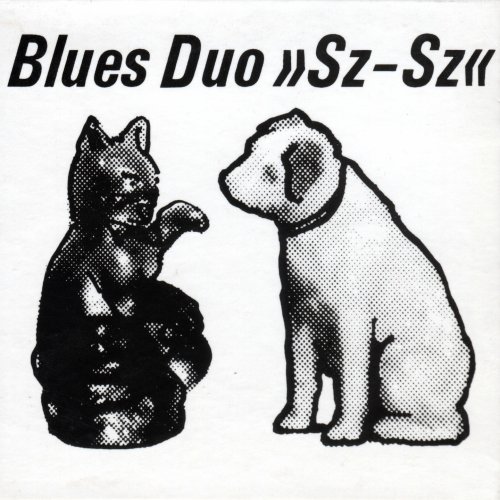
![Tomasz Stańko - Unit (Polish Radio Sessions vol. 2/6) (2025) [Hi-Res] Tomasz Stańko - Unit (Polish Radio Sessions vol. 2/6) (2025) [Hi-Res]](https://www.dibpic.com/uploads/posts/2025-12/1765790300_cover.jpg)
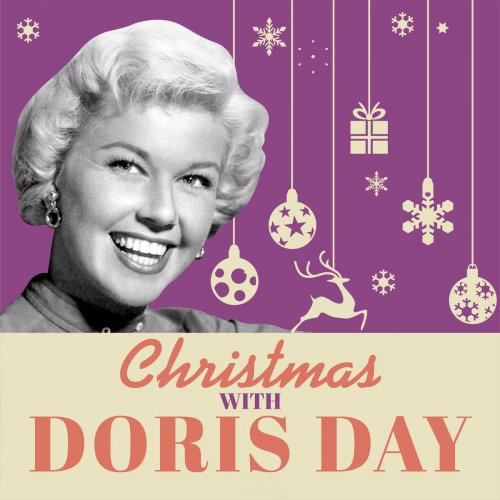
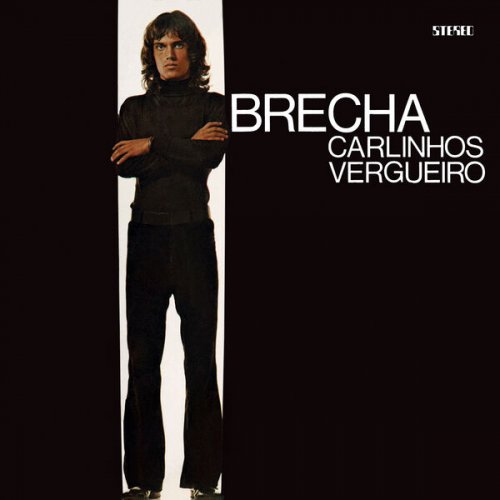

![Afrodream - Guiss Guiss (2025) [Hi-Res] Afrodream - Guiss Guiss (2025) [Hi-Res]](https://www.dibpic.com/uploads/posts/2025-12/1765638325_a2717494732_0.jpg)